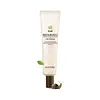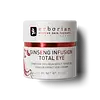What's inside
What's inside
 Key Ingredients
Key Ingredients

 Benefits
Benefits

 Concerns
Concerns

 Ingredients Side-by-side
Ingredients Side-by-side

Water
Skin ConditioningCetearyl Alcohol
EmollientMacadamia Ternifolia Seed Oil
EmollientNiacinamide
SmoothingButylene Glycol
HumectantSteareth-2
EmulsifyingSqualane
EmollientBear Oil
EmollientHydrogenated Cottonseed Oil
EmollientSteareth-21
CleansingCetyl Alcohol
EmollientAbies Alba Seed Extract
AntimicrobialBeta-Glucan
Skin ConditioningSimmondsia Chinensis Seed Oil
EmollientPanthenol
Skin ConditioningHydrogenated Palm Oil
EmollientOligopeptide-1
Skin ConditioningSaccharomyces/Caragana Sinica Root Ferment Extract
AntioxidantDimethicone
EmollientPropylene Glycol
HumectantLecithin
EmollientPropylparaben
PreservativeParfum
MaskingWater, Cetearyl Alcohol, Macadamia Ternifolia Seed Oil, Niacinamide, Butylene Glycol, Steareth-2, Squalane, Bear Oil, Hydrogenated Cottonseed Oil, Steareth-21, Cetyl Alcohol, Abies Alba Seed Extract, Beta-Glucan, Simmondsia Chinensis Seed Oil, Panthenol, Hydrogenated Palm Oil, Oligopeptide-1, Saccharomyces/Caragana Sinica Root Ferment Extract, Dimethicone, Propylene Glycol, Lecithin, Propylparaben, Parfum
Water
Skin ConditioningButylene Glycol
HumectantCyclomethicone
EmollientButyrospermum Parkii Butter
Skin ConditioningOctyldodecanol
EmollientCetearyl Alcohol
EmollientPalmitic Acid
EmollientTalc
AbrasivePanax Ginseng Root Extract
EmollientCentella Asiatica Extract
CleansingScutellaria Baicalensis Root Extract
AstringentPolygonum Cuspidatum Root Extract
AntioxidantGlycyrrhiza Glabra Root Extract
BleachingCamellia Sinensis Leaf Extract
AntimicrobialRosmarinus Officinalis Leaf Extract
AntimicrobialSaccharomyces Cerevisiae Extract
Skin ConditioningChamomilla Recutita Flower Extract
MaskingDioscorea Villosa Root Extract
Skin ConditioningEquisetum Giganteum Extract
Skin ConditioningKigelia Africana Fruit Extract
Skin ConditioningPrunus Amygdalus Dulcis Oil
Skin ConditioningHydrogenated Vegetable Oil
EmollientGlycine Soja Oil
EmollientSesamum Indicum Seed Oil
EmollientZea Mays Oil
EmulsifyingVegetable Oil
Skin ConditioningEthylhexylglycerin
Skin ConditioningTocopherol
AntioxidantTocopheryl Acetate
AntioxidantPanthenol
Skin ConditioningMannitol
HumectantArginine
MaskingStearyl Stearate
EmollientStearic Acid
CleansingGlyceryl Stearate
EmollientPEG-100 Stearate
Ozokerite
Emulsion StabilisingCera Alba
EmollientHydrogenated Palm Acid
Cellulose
AbsorbentHydroxypropyl Methylcellulose
Emulsion StabilisingAmmonium Acryloyldimethyltaurate/Vp Copolymer
Mica
Cosmetic ColorantPhenoxyethanol
PreservativeT-Butyl Alcohol
PerfumingCI 77891
Cosmetic ColorantCI 77492
Cosmetic ColorantWater, Butylene Glycol, Cyclomethicone, Butyrospermum Parkii Butter, Octyldodecanol, Cetearyl Alcohol, Palmitic Acid, Talc, Panax Ginseng Root Extract, Centella Asiatica Extract, Scutellaria Baicalensis Root Extract, Polygonum Cuspidatum Root Extract, Glycyrrhiza Glabra Root Extract, Camellia Sinensis Leaf Extract, Rosmarinus Officinalis Leaf Extract, Saccharomyces Cerevisiae Extract, Chamomilla Recutita Flower Extract, Dioscorea Villosa Root Extract, Equisetum Giganteum Extract, Kigelia Africana Fruit Extract, Prunus Amygdalus Dulcis Oil, Hydrogenated Vegetable Oil, Glycine Soja Oil, Sesamum Indicum Seed Oil, Zea Mays Oil, Vegetable Oil, Ethylhexylglycerin, Tocopherol, Tocopheryl Acetate, Panthenol, Mannitol, Arginine, Stearyl Stearate, Stearic Acid, Glyceryl Stearate, PEG-100 Stearate, Ozokerite, Cera Alba, Hydrogenated Palm Acid, Cellulose, Hydroxypropyl Methylcellulose, Ammonium Acryloyldimethyltaurate/Vp Copolymer, Mica, Phenoxyethanol, T-Butyl Alcohol, CI 77891, CI 77492
Ingredients Explained
These ingredients are found in both products.
Ingredients higher up in an ingredient list are typically present in a larger amount.
Butylene Glycol (or BG) is used within cosmetic products for a few different reasons:
Overall, Butylene Glycol is a safe and well-rounded ingredient that works well with other ingredients.
Though this ingredient works well with most skin types, some people with sensitive skin may experience a reaction such as allergic rashes, closed comedones, or itchiness.
Learn more about Butylene GlycolCetearyl alcohol is a mixture of two fatty alcohols: cetyl alcohol and stearyl alcohol. It is mainly used as an emulsifier. Emulsifiers help prevent the separation of oils and products. Due to its composition, it can also be used to thicken a product or help create foam.
Cetearyl alcohol is an emollient. Emollients help soothe and hydrate the skin by trapping moisture.
Studies show Cetearyl alcohol is non-toxic and non-irritating. The FDA allows products labeled "alcohol-free" to have fatty alcohols.
This ingredient is usually derived from plant oils such as palm, vegetable, or coconut oils. There is debate on whether this ingredient will cause acne.
Due to the fatty acid base, this ingredient may not be Malassezia folliculitis safe.
Learn more about Cetearyl AlcoholPanthenol is a common ingredient that helps hydrate and soothe the skin. It is found naturally in our skin and hair.
There are two forms of panthenol: D and L.
D-panthenol is also known as dexpanthenol. Most cosmetics use dexpanthenol or a mixture of D and L-panthenol.
Panthenol is famous due to its ability to go deeper into the skin's layers. Using this ingredient has numerous pros (and no cons):
Like hyaluronic acid, panthenol is a humectant. Humectants are able to bind and hold large amounts of water to keep skin hydrated.
This ingredient works well for wound healing. It works by increasing tissue in the wound and helps close open wounds.
Once oxidized, panthenol converts to pantothenic acid. Panthothenic acid is found in all living cells.
This ingredient is also referred to as pro-vitamin B5.
Learn more about PanthenolWater. It's the most common cosmetic ingredient of all. You'll usually see it at the top of ingredient lists, meaning that it makes up the largest part of the product.
So why is it so popular? Water most often acts as a solvent - this means that it helps dissolve other ingredients into the formulation.
You'll also recognize water as that liquid we all need to stay alive. If you see this, drink a glass of water. Stay hydrated!
Learn more about Water